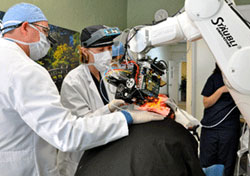In the latter part of the 1950s, Dr. Norman Orentreich, a dermatologist, introduced the method of hair transplantation in the country. Although the idea has been around decades earlier in Japan, it wasn’t until that time that doctors in the United States adopted the idea. The basic concept of hair transplantation is simple; hairs that grow on the back and sides of the head are used and redistributed to areas that are suffering from lack of hair such as the front and top portion of the head, as in most cases of male hair loss. Over the years, there have been a lot of developments in hair transplant technology and we’ve surely come a long way from the hair plugs that used to dominate the market in the 70s and 80s.

The Best in Hair Transplant Technology
Many of the most competent hair transplant surgeons today know how to perform a method called follicular hair extraction or FUE. This method is considered the best in hair transplant technology because it offers a lot of benefits to the patient. Although it is undoubtedly the more expensive choice, it is a far better method to use than its predecessor, which is the follicular unit transplantation (FUT), also known as the Strip Method. Here are some of the known benefits of FUE:
- It does not cause scarring
- It ensures a faster healing period
- No incisions are made so it does not need stitching
- No bandages are needed
- It can give the patient a more natural-looking hair transplant
- It does not require a 2nd session to complete the transplantation
Mini Micrografting
Yet another newly developed hair transplant technology, the mini micrografting method is quite similar to FUT however the only difference is that the specialist sets the size of the graft. Basically, he or she will cut the donor tissue based on the patient’s requirements with the use of a multi-bladed knife. The grafts are larger in size and the wounds are larger as well. This procedure is definitely cheaper than FUE however it could give rise to many post-operation problems such as scarring, swelling, cysts, infection, slow hair growth, and even numbness on the scalp.
Hair Cloning
Although it is still currently being researched and studied, the idea of hair cloning is considered to be the latest in hair transplant technology. Researchers from the University of Pennsylvania’s College of Medicine discovered that hair could grow with new tissues. To prove this, they isolated stem cells from human hair follicles and then obtained dermal papilla cells, which they cultured in a laboratory, under optimal conditions. With the use of hair cloning, specialists can have access to thousands of hair follicles from only one hair, making it very ideal and convenient for them to conduct hair transplant surgeries on their patients without needing a lot of donor hair anymore. Such hair transplant technology is still continuously being developed and will probably take years before it can be introduced to the market.
